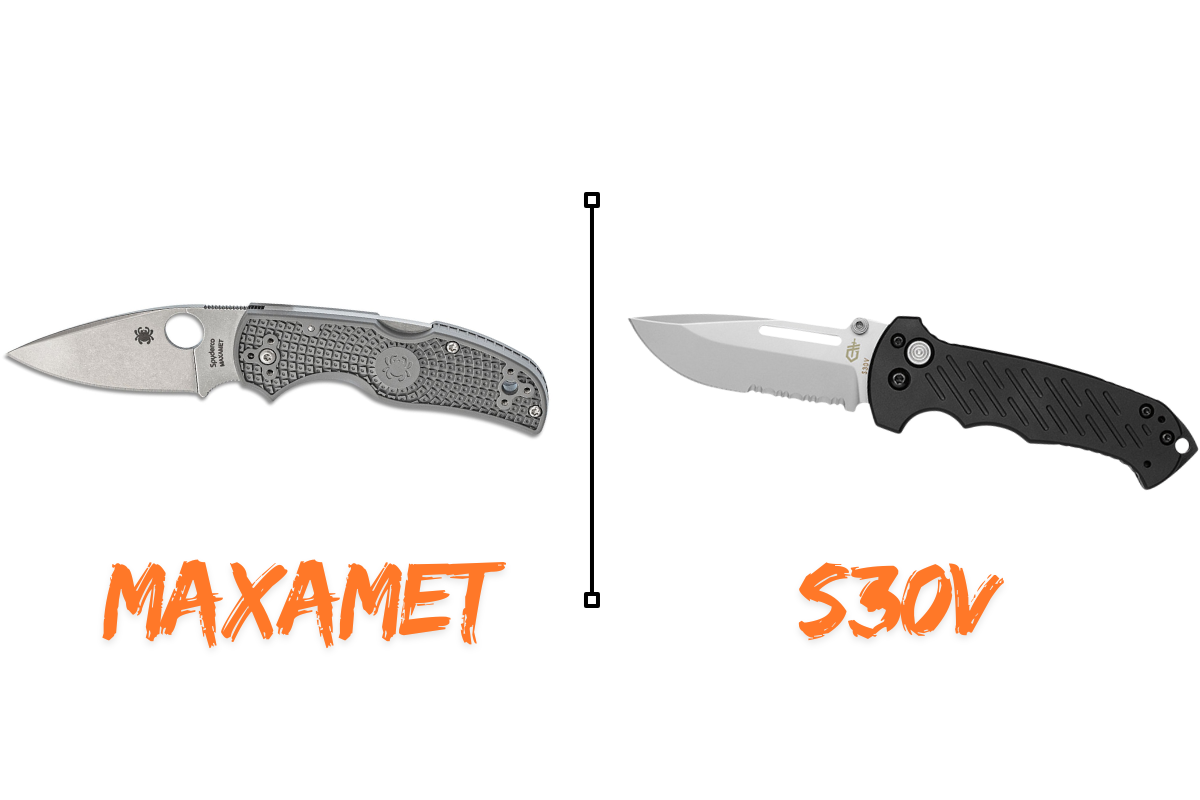The world of premium knife steels presents a fascinating contrast between Maxamet, a cutting-edge powder metallurgy steel, and S30V, an established high-performance stainless steel. While both materials serve in high-end cutlery, their characteristics and optimal applications differ significantly.
Chemical Composition
| Element | Maxamet | S30V |
|---|---|---|
| Carbon | 2.15% | 1.45% |
| Tungsten | 13% | — |
| Cobalt | 10% | — |
| Vanadium | 6% | 4% |
| Chromium | 4% | 14% |
| Molybdenum | — | 2% |
Maxamet’s composition reflects its origins as a high-speed tool steel, with exceptional amounts of tungsten and cobalt[1]. The substantial tungsten content (13%) contributes to remarkable hardness and wear resistance, while the 10% cobalt enables higher carbon saturation in the alloy, indirectly increasing hardness[1].
S30V, designed specifically for cutlery, features a more balanced composition focused on practical knife performance. Its 14% chromium content establishes excellent corrosion resistance, while the 4% vanadium promotes wear resistance and refined grain structure[2]. The 1.45% carbon content, though lower than Maxamet’s, still qualifies it as a high-carbon steel[2].
Performance Characteristics
Edge Retention
Edge retention testing reveals dramatic differences between these steels:
- Maxamet: 563 cuts in standardized rope cutting tests[6]
- S30V: 175 cuts under identical conditions[6]
This remarkable difference stems from Maxamet’s unique composition and extremely high hardness potential. The high tungsten and vanadium content forms extremely hard carbides that resist wear significantly better than conventional steel compositions[1].
Hardness
- Maxamet: Can achieve hardness levels up to 70 HRC
- S30V: Typically heat treated to 58-62 HRC[2]
Manufacturing Process
Both steels utilize powder metallurgy (PM) manufacturing, but with different approaches:
Maxamet Production:
- Inert gas atomization
- Hot isostatic pressing (HIP)
- Results in 100% dense billets with extremely homogeneous composition[4]
S30V Production:
- Conventional PM process
- Focuses on promoting vanadium carbide formation
- Produces uniform, high-quality steel with superior dimensional stability[5]
Heat Treatment Considerations
The heat treatment protocols for these steels differ substantially, reflecting their unique metallurgical characteristics:
Maxamet Heat Treatment
- Preheating: Three stages required (1450°F, 1850°F, and 2050°F)
- Austenitizing temperature: 2150-2175°F
- Quenching: Must be performed in vacuum or high-purity inert gas
- Tempering: Multiple cycles at 1025°F
The complex heat treatment process for Maxamet requires precise temperature control and specialized equipment. This contributes significantly to its higher production costs and limited availability.
S30V Heat Treatment
- Single preheating stage: 1500°F
- Austenitizing temperature: 1950-2050°F
- Conventional quenching possible
- Tempering: Double tempering at 400-750°F
S30V’s more forgiving heat treatment process makes it more accessible to manufacturers while still achieving excellent properties.
Real-World Performance Analysis
Edge Stability
Maxamet demonstrates superior edge stability under heavy use:
- Maintains microscopic edge geometry longer
- Resists deformation at higher temperatures
- Shows minimal microchipping when properly heat treated
S30V exhibits good edge stability for most applications:
- Balanced performance between toughness and wear resistance
- More resistant to chipping than Maxamet
- Better edge retention than most conventional stainless steels
Corrosion Resistance
| Property | Maxamet | S30V |
|---|---|---|
| Salt Spray Test (hours) | 24 | 96 |
| Relative Corrosion Rating | Poor | Excellent |
| Surface Oxidation | High | Minimal |
Practical Applications
Maxamet Optimal Uses:
- Industrial cutting tools
- High-volume processing operations
- Premium EDC knives for experienced users
- Applications requiring extreme edge retention
S30V Optimal Uses:
- Everyday carry knives
- Hunting and outdoor applications
- Marine environments
- Kitchen cutlery
Sharpening and Maintenance
Sharpening Characteristics
Maxamet:
- Requires diamond abrasives due to extreme hardness
- Longer sharpening time needed compared to conventional steels
- Initial sharpening difficulty rating: Very High
- Best results with progression: 200 -> 400 -> 800 -> 1200 grit diamonds
S30V:
- Can be sharpened with conventional stones, though diamonds preferred
- Moderate sharpening time required
- Initial sharpening difficulty rating: Moderate
- Accepts a highly refined edge more readily
Cost-Benefit Analysis
| Factor | Maxamet | S30V |
|---|---|---|
| Raw Material Cost | $$$$$ | $$$ |
| Processing Cost | $$$$ | $$ |
| Manufacturing Complexity | Very High | Moderate |
| Relative Price Point | 300-400% higher | Baseline |
Frequently Asked Questions
Q: Is Maxamet worth the premium price over S30V?
For users requiring extreme edge retention and willing to maintain the blade properly, Maxamet’s performance justifies its cost. However, S30V offers better value for most users.
Q: How does the corrosion resistance compare in real-world use?
S30V significantly outperforms Maxamet in corrosion resistance. Maxamet requires regular maintenance and oil application to prevent oxidation, while S30V remains stable in most environments.
Q: Which steel is better for everyday carry (EDC)?
S30V is generally better suited for EDC due to its balanced properties and corrosion resistance. Maxamet excels in specialized applications where edge retention is paramount.
Q: Can these steels be sharpened at home?
Both can be sharpened at home, but Maxamet requires significant expertise and diamond abrasives. S30V is more user-friendly for home maintenance.
Conclusion and Recommendations
Professional Use
- Heavy Industrial: Choose Maxamet for its superior wear resistance and edge retention
- Food Service: Opt for S30V due to better corrosion resistance and easier maintenance
- Outdoor/Hunting: S30V provides better all-around performance
Hobbyist Use
- Collectors: Both steels have their place, with Maxamet representing the cutting edge of performance
- EDC Enthusiasts: S30V offers better value and practicality
- Beginning Users: S30V is more forgiving and easier to maintain
The choice between Maxamet and S30V ultimately depends on specific use cases and user expertise. While Maxamet represents the pinnacle of edge retention and wear resistance, S30V offers a more practical balance of properties for most users.
SEO Title: Maxamet vs S30V Steel: Ultimate Performance Guide
Meta Description: Comprehensive comparison of Maxamet and S30V knife steels, analyzing composition, edge retention, hardness, and real-world performance for informed decision-making.
Citations:
[1] https://bladeops.com/blog/knife-steel-maxamet-steel/
[2] https://blog.hdmdknives.com/s30v-steel.html
[3] https://knifesteelnerds.com/2020/05/01/testing-the-edge-retention-of-48-knife-steels/
[4] https://www.carpentertechnology.com/blog/powder-metal-alloy-bridges-the-gap
[5] https://www.hudsontoolsteel.com/technical-data/steelCPMS30V
[6] https://www.everydaycommentary.com/www.everydaycommentary.com/2017/7/7/cedric-and-adas-steel-test-and-results

Leave a Reply